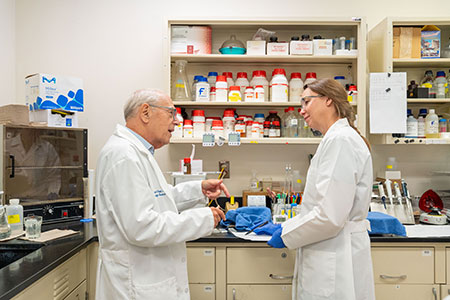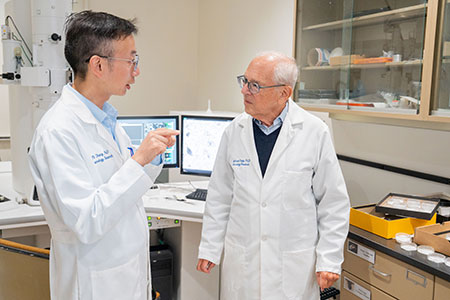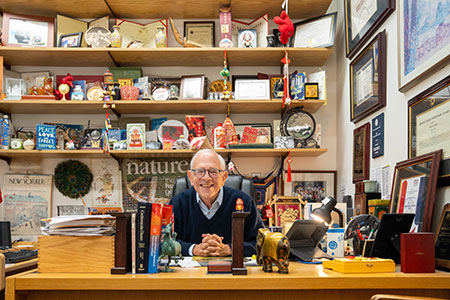HFI Innovator Spotlight: Dr. Michael Chopp, PhD
Unlocking how cells communicate
Dr. Chopp’s work with extracellular vesicles may change the prognosis for neurological injury and disease, and cancer.
Michael Chopp, PhD, and his team have demonstrated how to use our body’s own biology to treat a host of conditions such as stroke, traumatic brain injuries, dementia, peripheral neuropathy, neurodegenerative diseases, and a variety of cancers.
The concept seems so simple, yet its implications are profound. In his spirited manner, and with an obvious passion for discovery, Dr. Chopp explains this game-changing approach to treating some of the most common – and devastating – diseases.

It all started when scientists began taking an interest in stem cells back in the 1990s. Dr. Chopp and his team pioneered the use of stem cells such as mesenchymal stromal cells, for the IV treatment of stroke, neural injury and neurodegenerative diseases. Among his awards, he received recognition for this foundational work from the American Hospital Association in 2001 as a Top Medical Advancement. The general consensus at the time was that stem cells replaced dead or damaged cells.
“I thought that was absurd,” he said. “Then I thought after you have a stroke, God forbid, people get better. The common assumption was that people relearn. And I had a sense that, no, the body really makes a desperate attempt to remodel itself, in some ways, to try and follow the same patterns as natural development.”
Regenerate vs. replace
With his team in the Henry Ford Department of Neurology, he began to take a closer look at what was really happening with the stem cells. His research in animals showed that when you administer stem cells after a neural injury they don’t replace damaged cells, they help the body regenerate new cells and neural rewiring. That’s how Henry Ford pioneered the entire field of restorative neurology. Dr. Chopp’s team was among the first to show that neurogenesis – or rebirth – is present post neural injury or post stroke. They also showed regeneration of blood vessels and synapses within the central nervous system, including the brain and the spinal cord.
“Then I said, ‘what’s going on? How are these stem cells inducing neurovascular remodeling and thereby enhancing neurological recovery?’. They have to be talking, communicating to the environment, telling the surrounding tissue and cells what to do. So they get into the body and then they give orders to amplify, to stimulate the neurogenesis, the angiogenesis and the synaptogenesis. That’s how I got into the extracellular vesicle-exosome business.”

‘Stem cells are juicy. They’re designed to do something in life.’
The next breakthrough came when he discovered that while stem cells are definitely designed to do great things, it wasn’t the stem cells themselves that were the communicators, but biological nanoparticles generated by the stem cells. Dr. Chopp harvested small extracellular vesicles (sEVs) from stem cells and demonstrated that the harvested sEVs when administered to an animal with a neurological injury or deficit provide, at the very least, the therapeutic benefit originally induced by the stem cell treatment.
What was doing the work were sEVs, including exosomes. They play a crucial role in intercellular communication. And, they are generated not only by stem cells, but by nearly all cells. Dr. Chopp’s research has revealed that sEVs can be harvested from cells and optimized for therapeutic use, providing transformative treatments.
The sEVs contain proteins, lipids, and genetic instructions, a variety of RNAs, which, when internalized by recipient cells, regulate the cell’s function.
“EVs are really how the body talks, how cells and organs talk to each other,” he said. “And if you can control the communication, you control the biology.”
A novel technology to produce and use sEVs, including exosomes
Dr. Chopp and his team took this knowledge and developed a platform biological technology.
“We harvested the sEVs from stem cells and other cells…We proceeded to significantly ‘improve on nature’ and to selectively engineer the content of the sEVs, particularly the microRNAs (miRs), to substantially amplify the therapeutic benefit of naïve sEVs. Not only have we demonstrated the robust therapeutic capabilities of these vesicles in a myriad of conditions, but we have also engineered them for amplified therapeutic benefits, paving the way for future medical interventions.”
Presently, the team is using specific populations of cells and means to treat and harvest these cells to generate sEVs that can be readily scaled up for clinical application, with the cells and their sEVs being highly consistent and reproducible. These biologics are safe and ready to be manufactured to scale, something no one else is doing right now. Administered to patients via IV, “we can treat them in a very select way, a totally healthy, normal way.”
Adding to the potential efficacy is the ability of the sEVs to cross the blood/brain barrier, making them especially useful in treating brain cancers and neurological conditions.

From physics professor to researcher
A theoretical and solid-state physicist by training, Dr. Chopp became fascinated by how he could apply his discipline to neuroscience when he was working as a professor at Oakland University.
A neurosurgeon friend thought he would be interested in watching a procedure to treat hydrocephalus since it deals with pressure on the brain and so is related a bit to physics. But Dr. Chopp noticed something else.
“The pulsation seemed to correspond to the arterial pulse. But the frequency components of the waveforms (the visual representation of how the heart is pumping over time) were very different,” he said. “So I said, there’s information here. I asked him, ‘are waveforms modified based on the disease state?’ And he said, ‘no one’s ever asked the question.’”
And that was it.
“I then dropped my physics research and set up a lab and did a deep mathematical analysis of intracranial pressures driven by an arterial input pressure and demonstrated that the change in the frequency of the spinal fluid pulsations really reflects the status of the vessels. And then it actually went to clinical applications.”
About a year later, in 1981, he heard about research being conducted in magnetic spectroscopy at Henry Ford. He actually volunteered as a researcher at Henry Ford at first but by 1983 he was directing the lab and has been the principal researcher ever since. His team has changed the way we treat stroke and so many other devastating conditions, impacting countless patients.
So how does a mind like his work? Where does that junction of science and creativity come from?
“I like asking questions and just being curious,” he said. “I like knowing and understanding and trusting my own ignorance. If I don't understand, that means probably other people also don't understand.”
.svg?iar=0&hash=F6049510E33E4E6D8196C26CCC0A64A4)
/hfh-logo-main--white.svg?iar=0&hash=ED491CBFADFB7670FAE94559C98D7798)